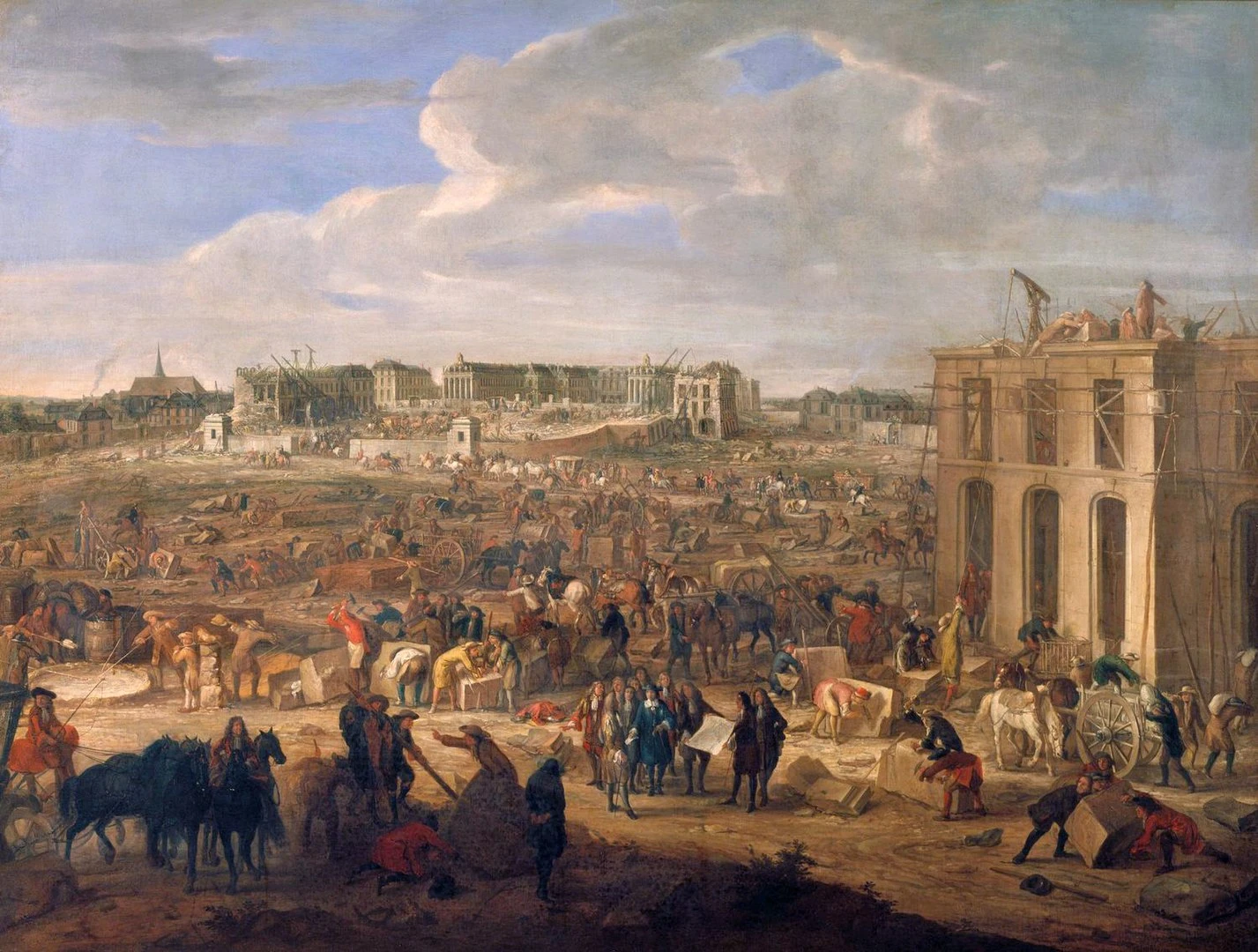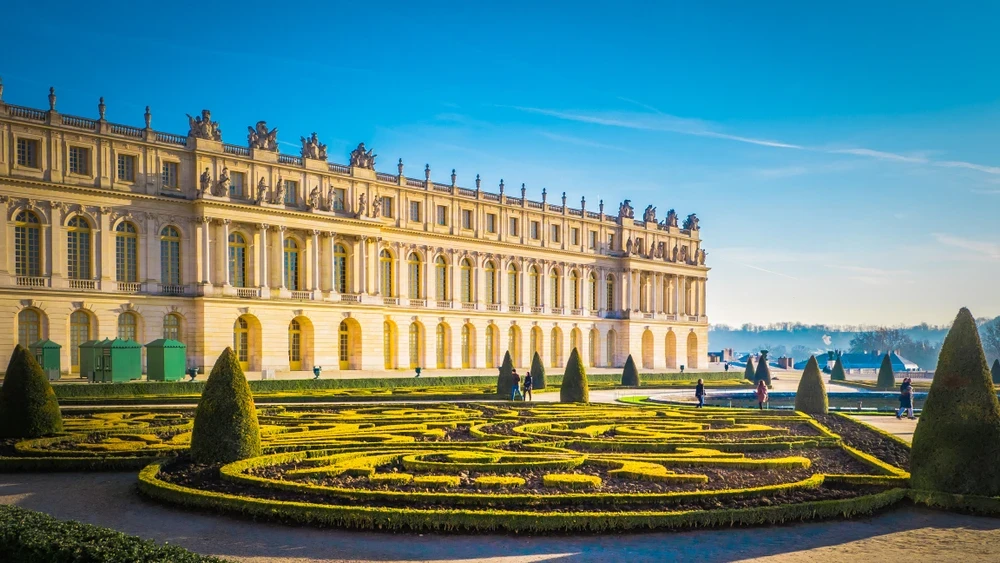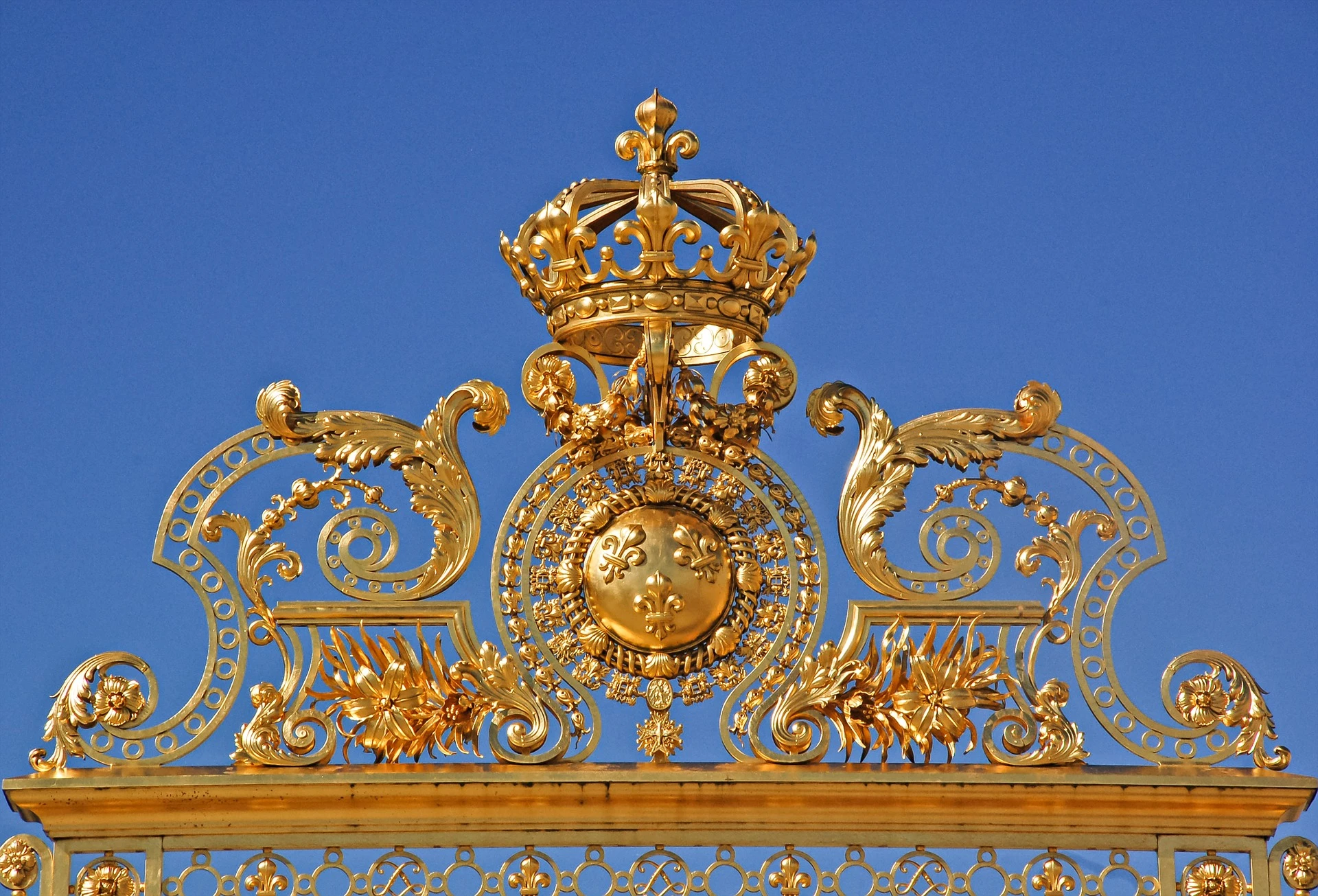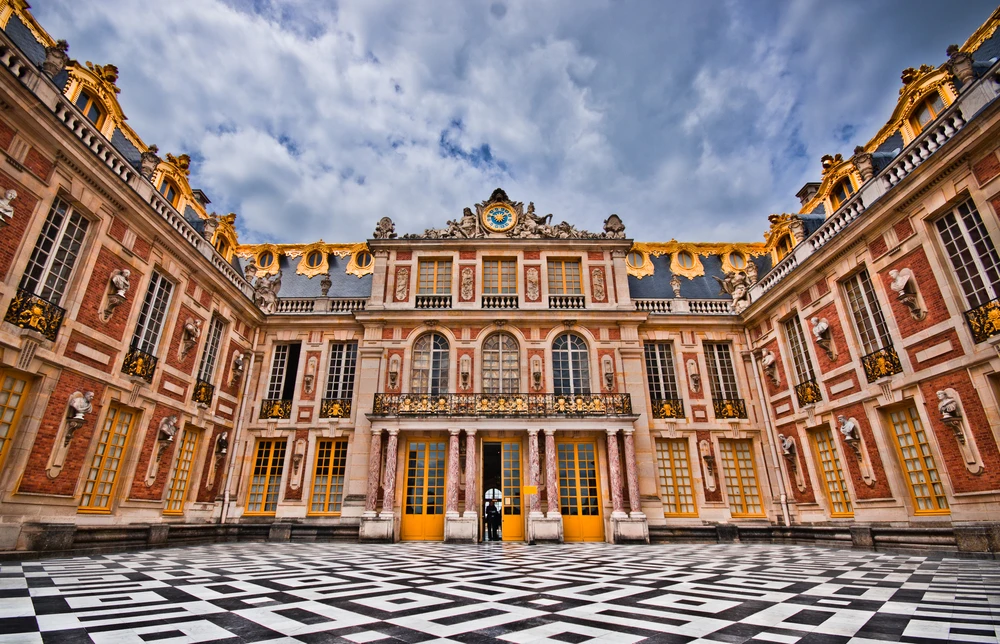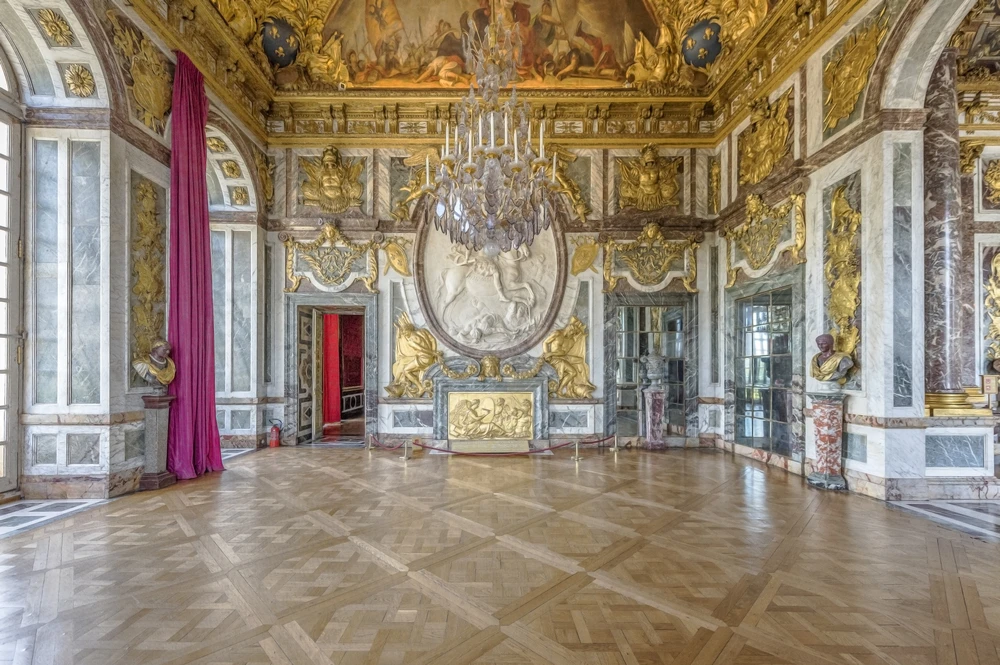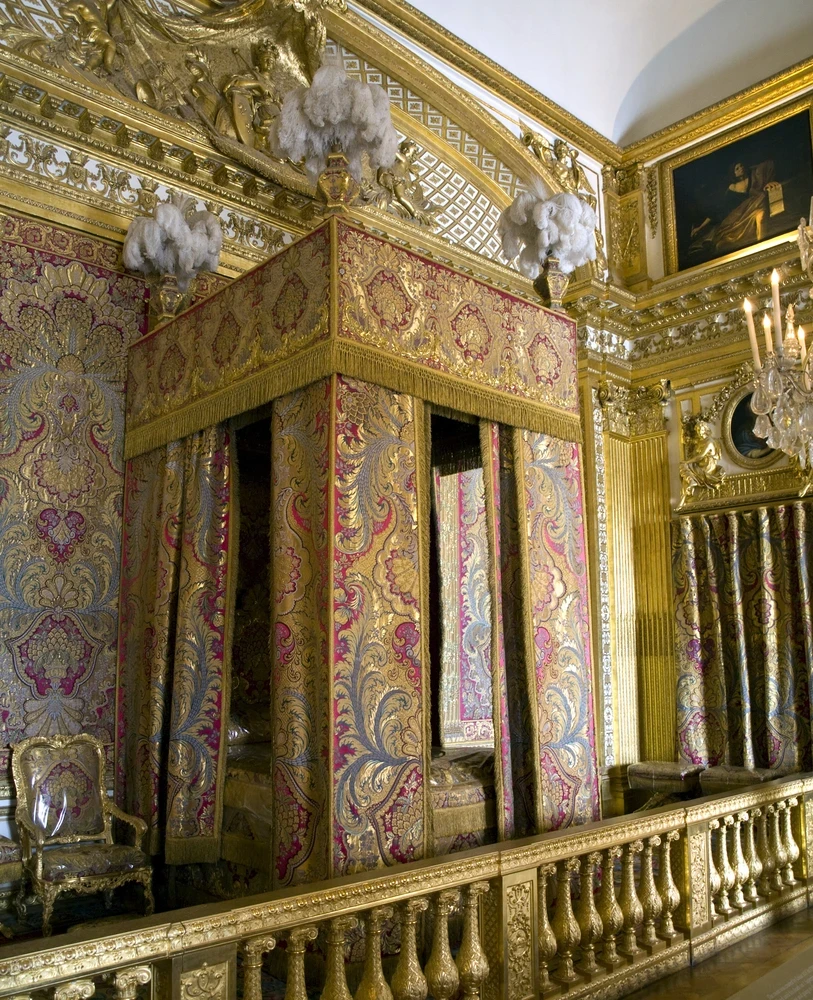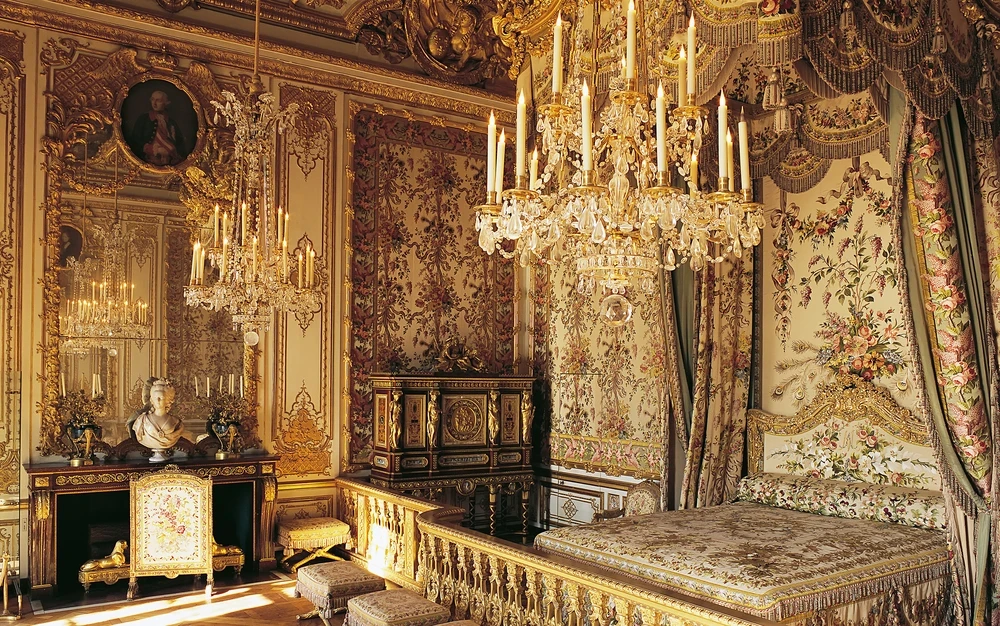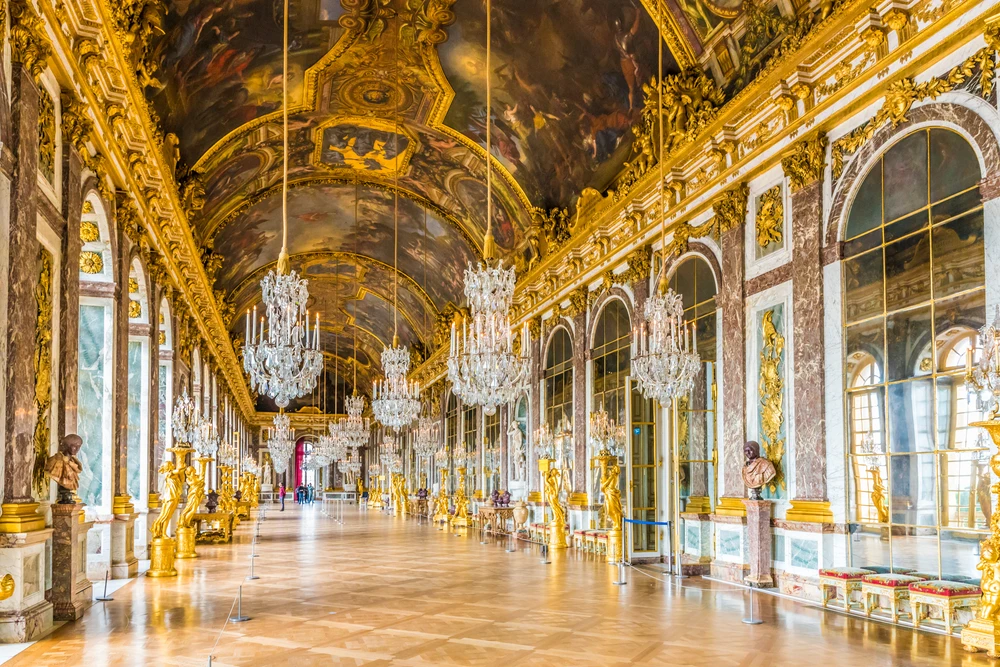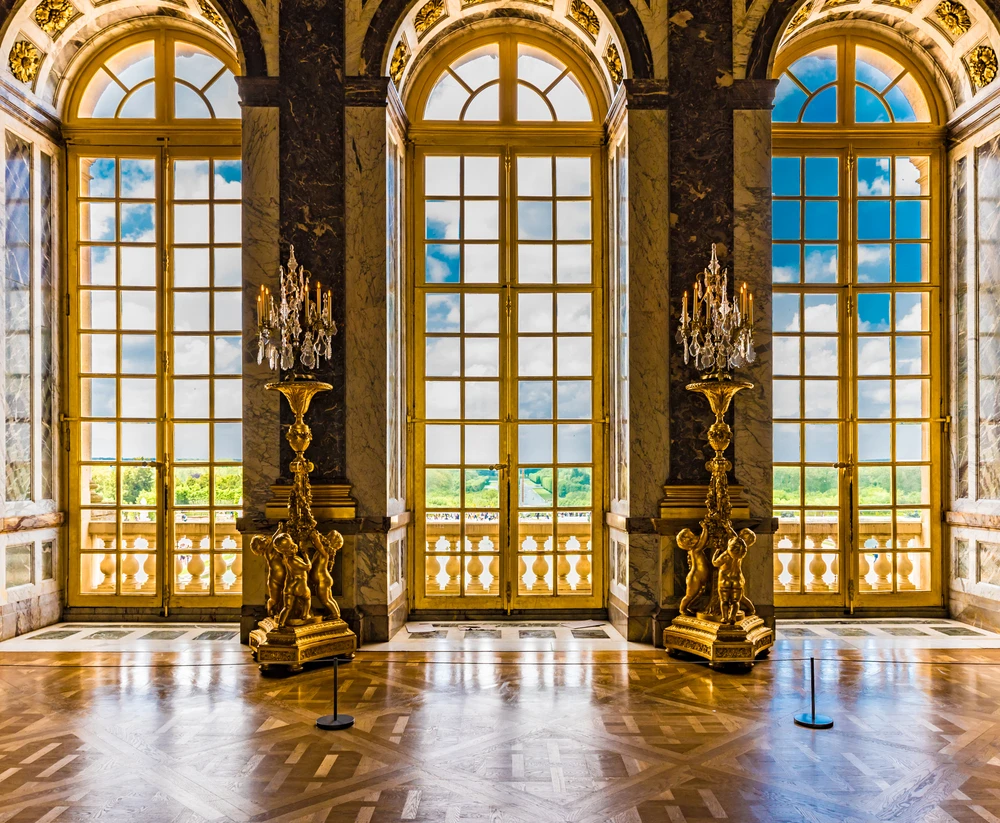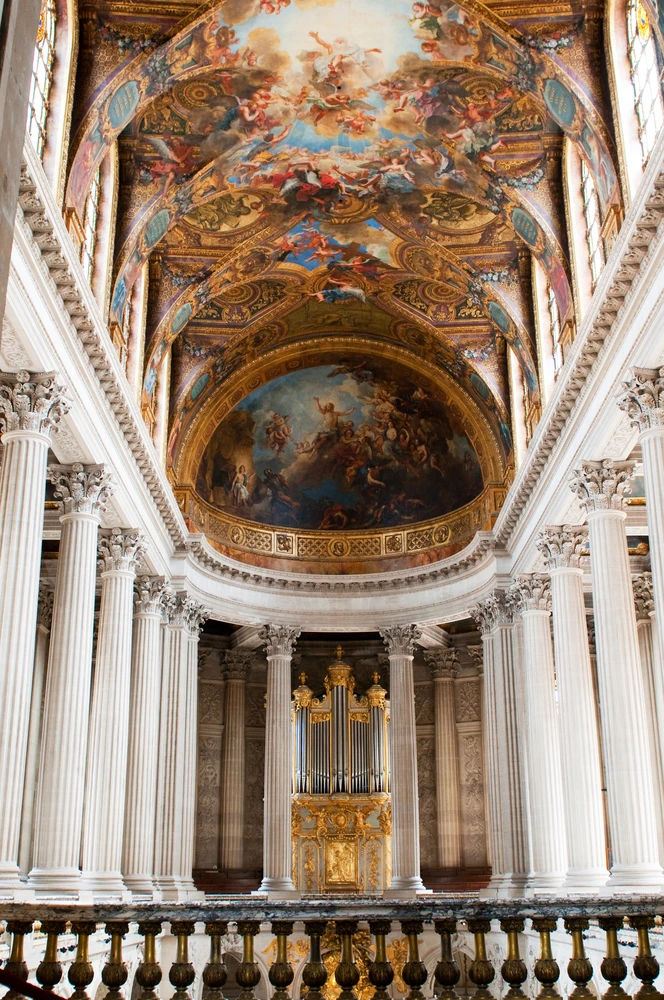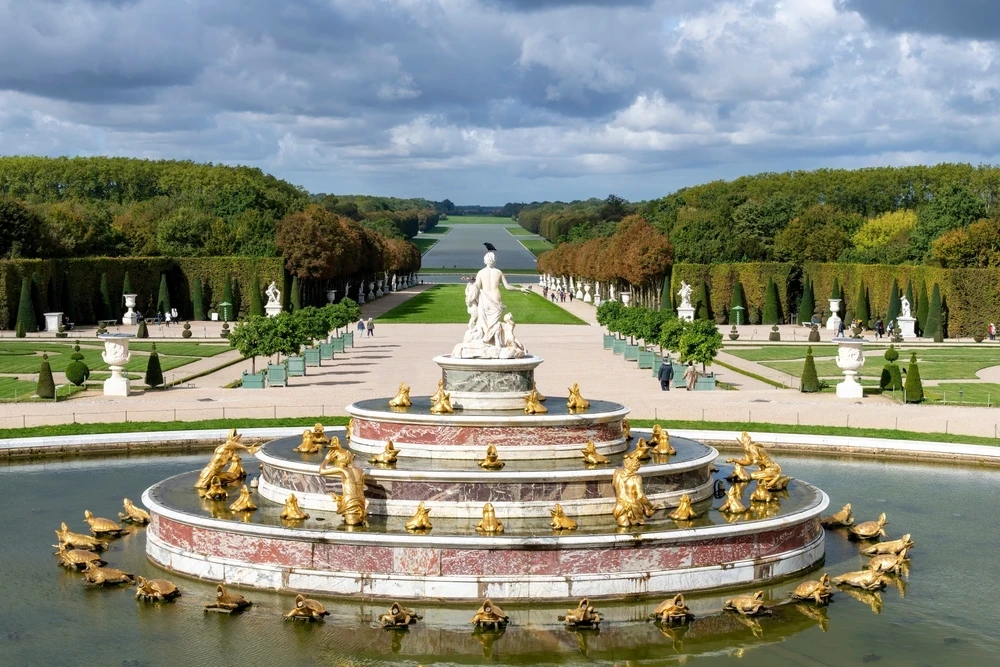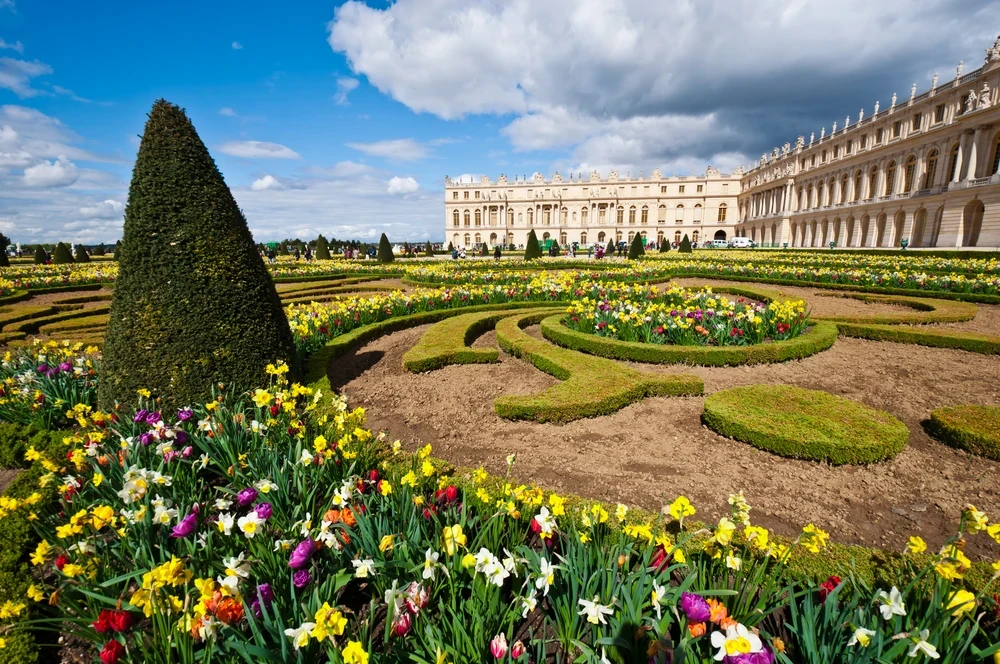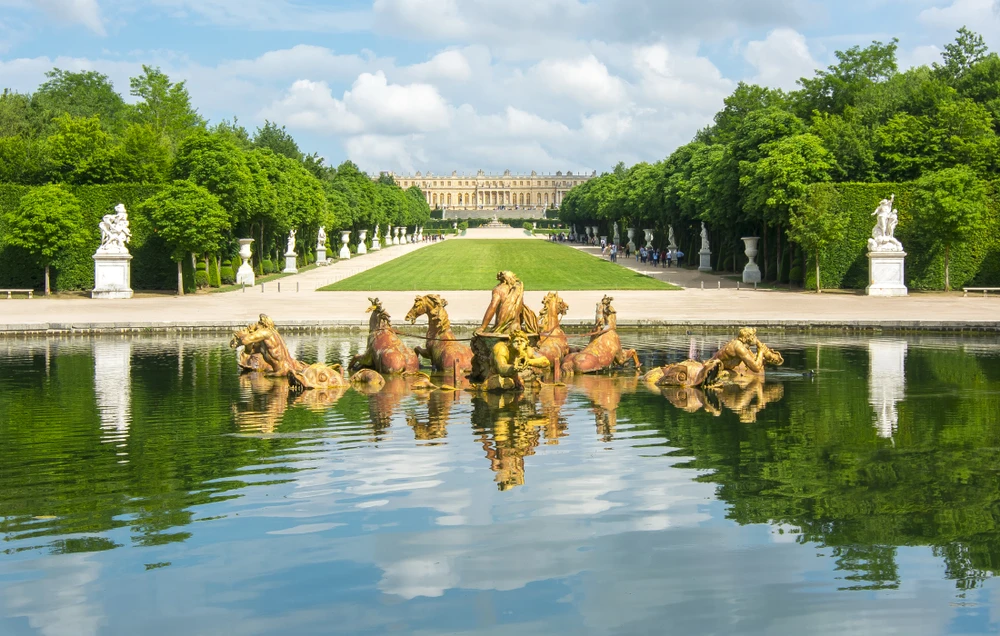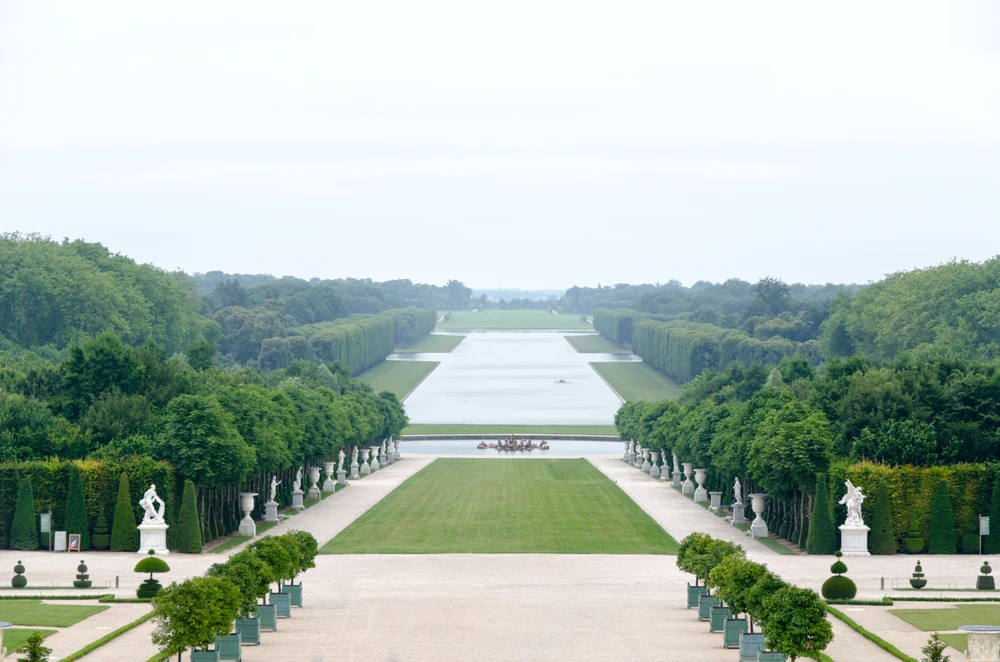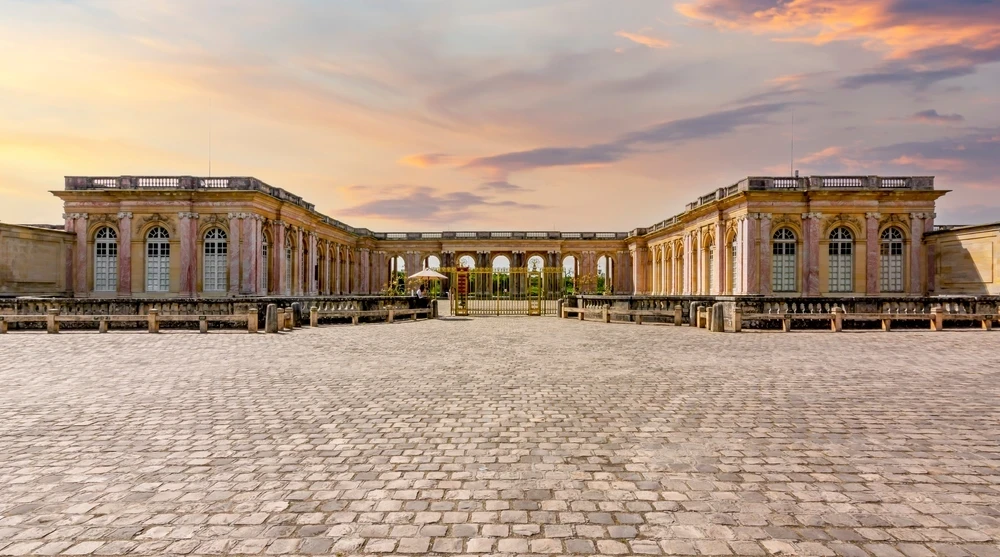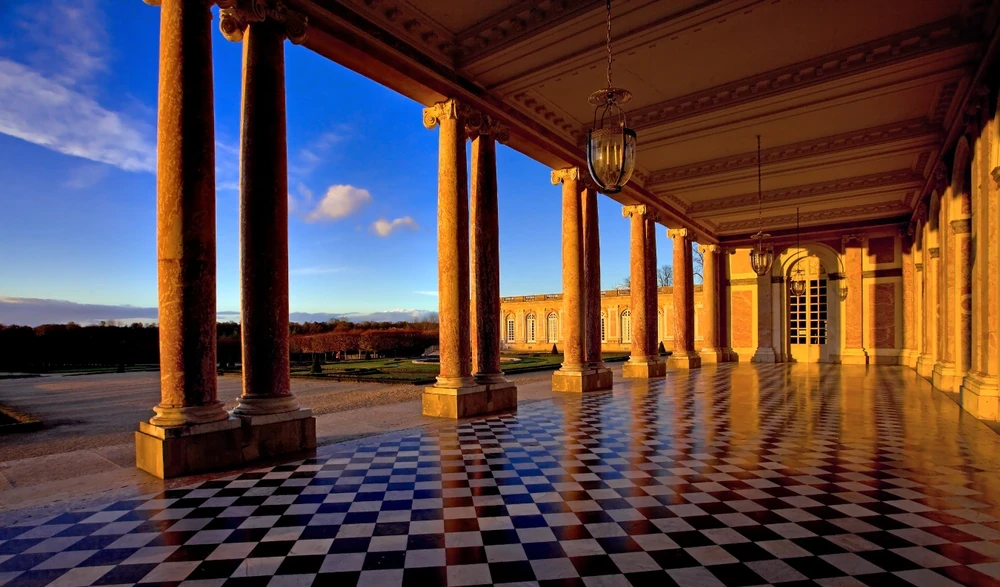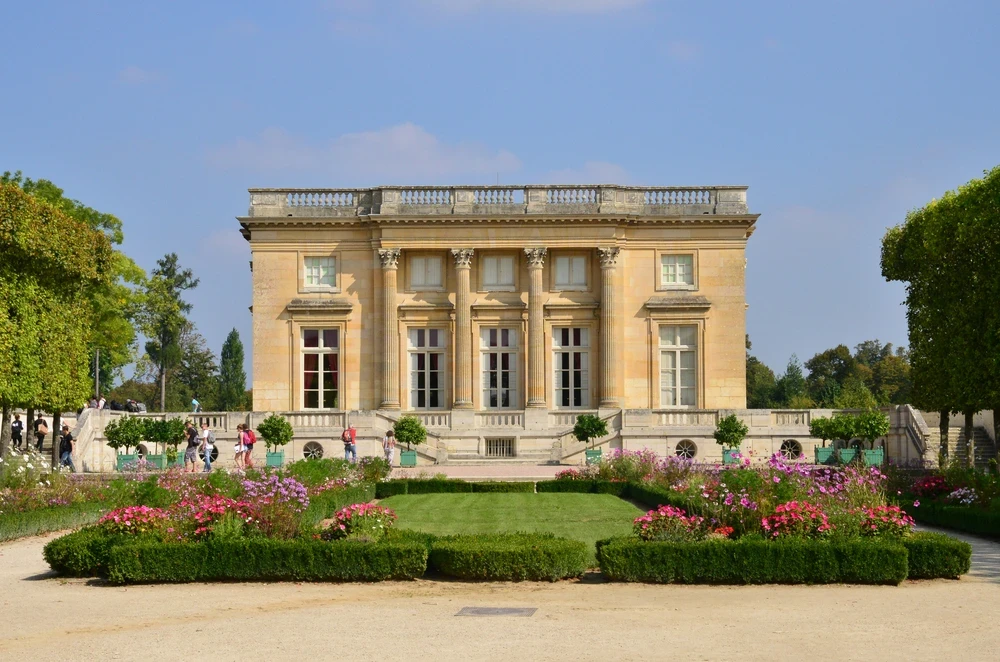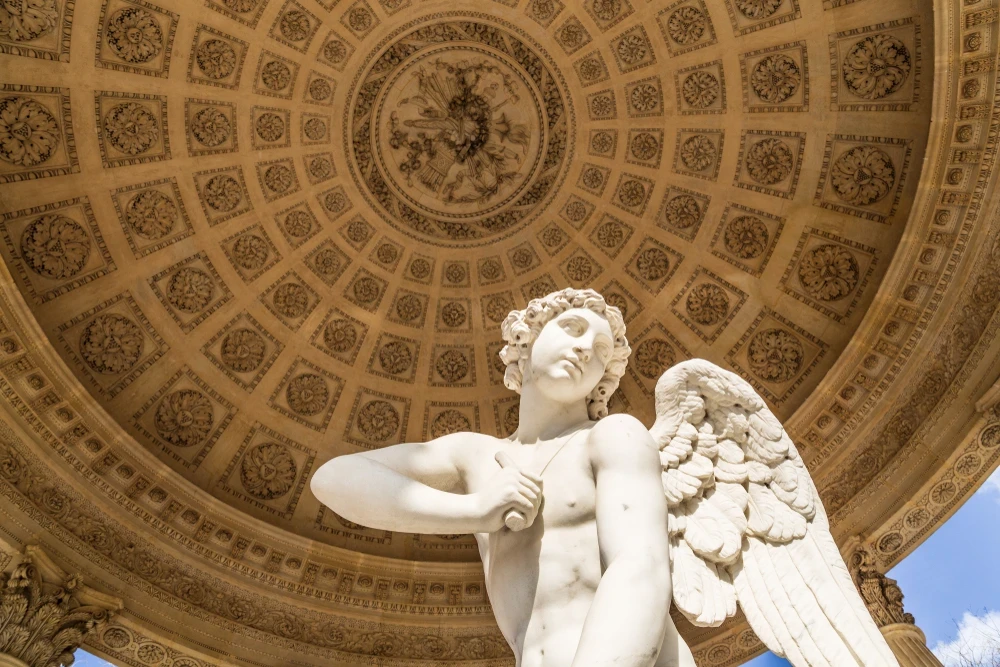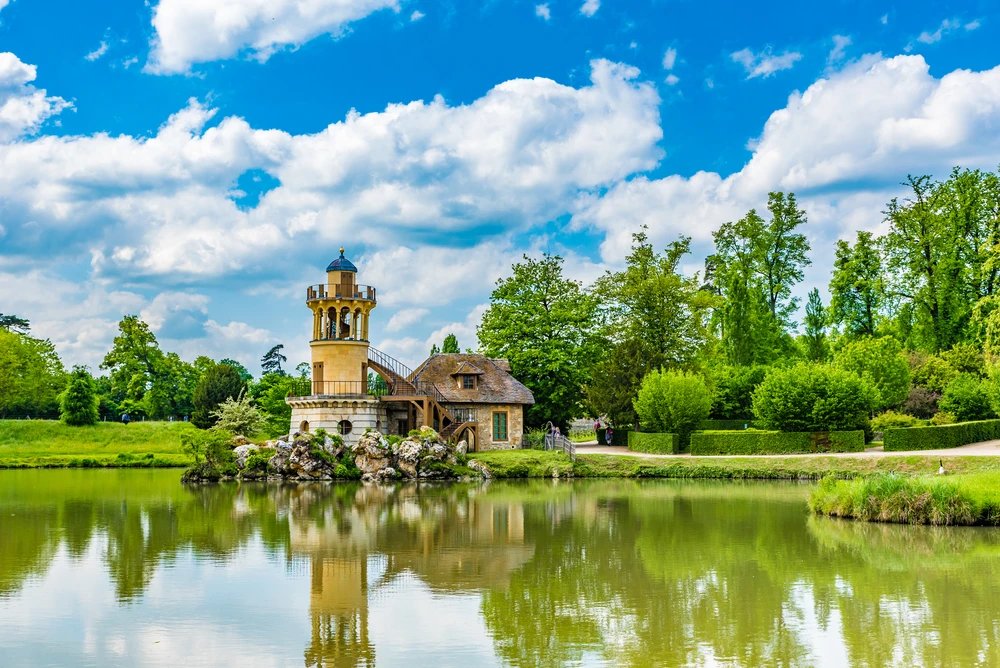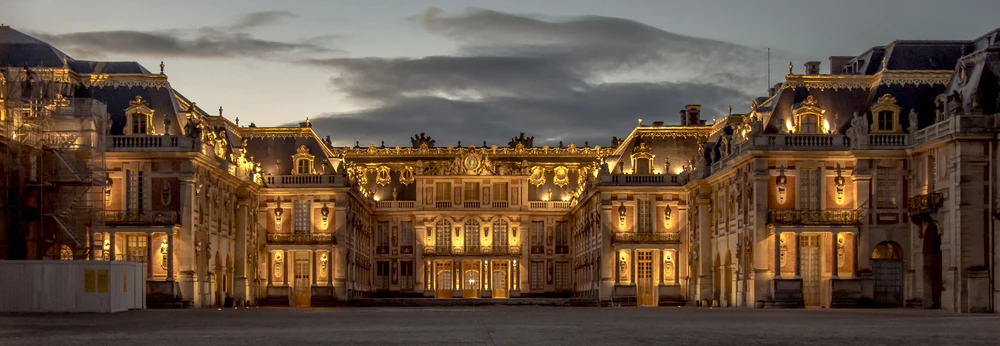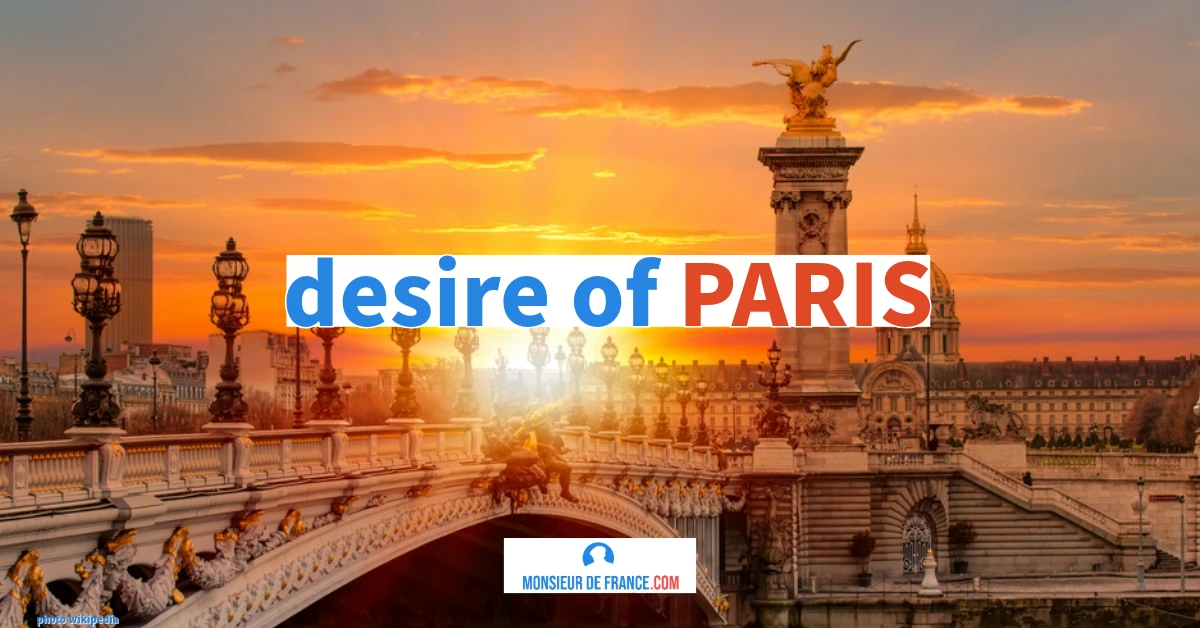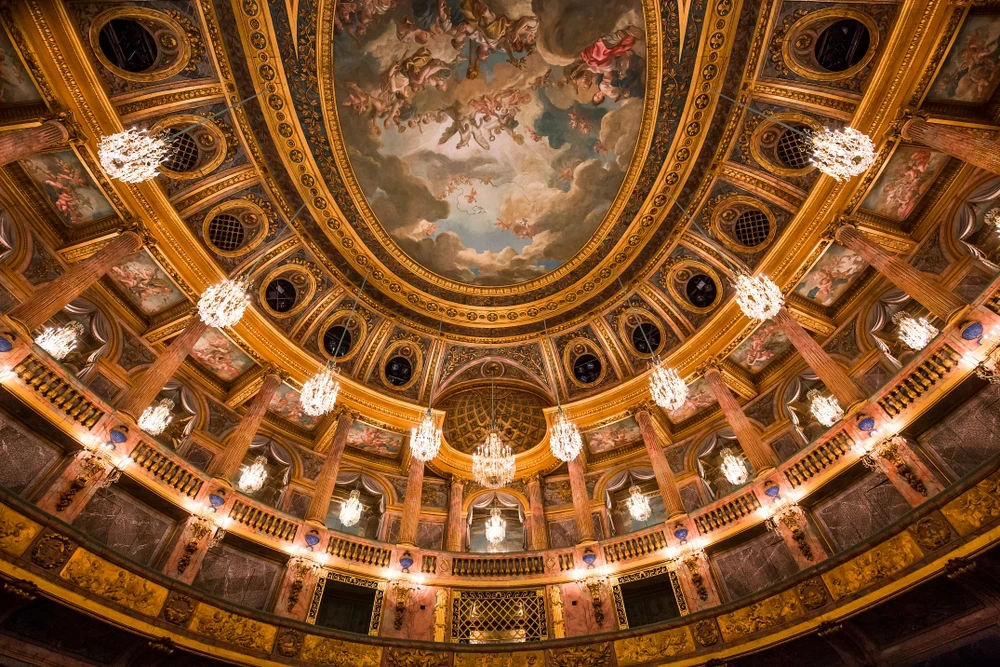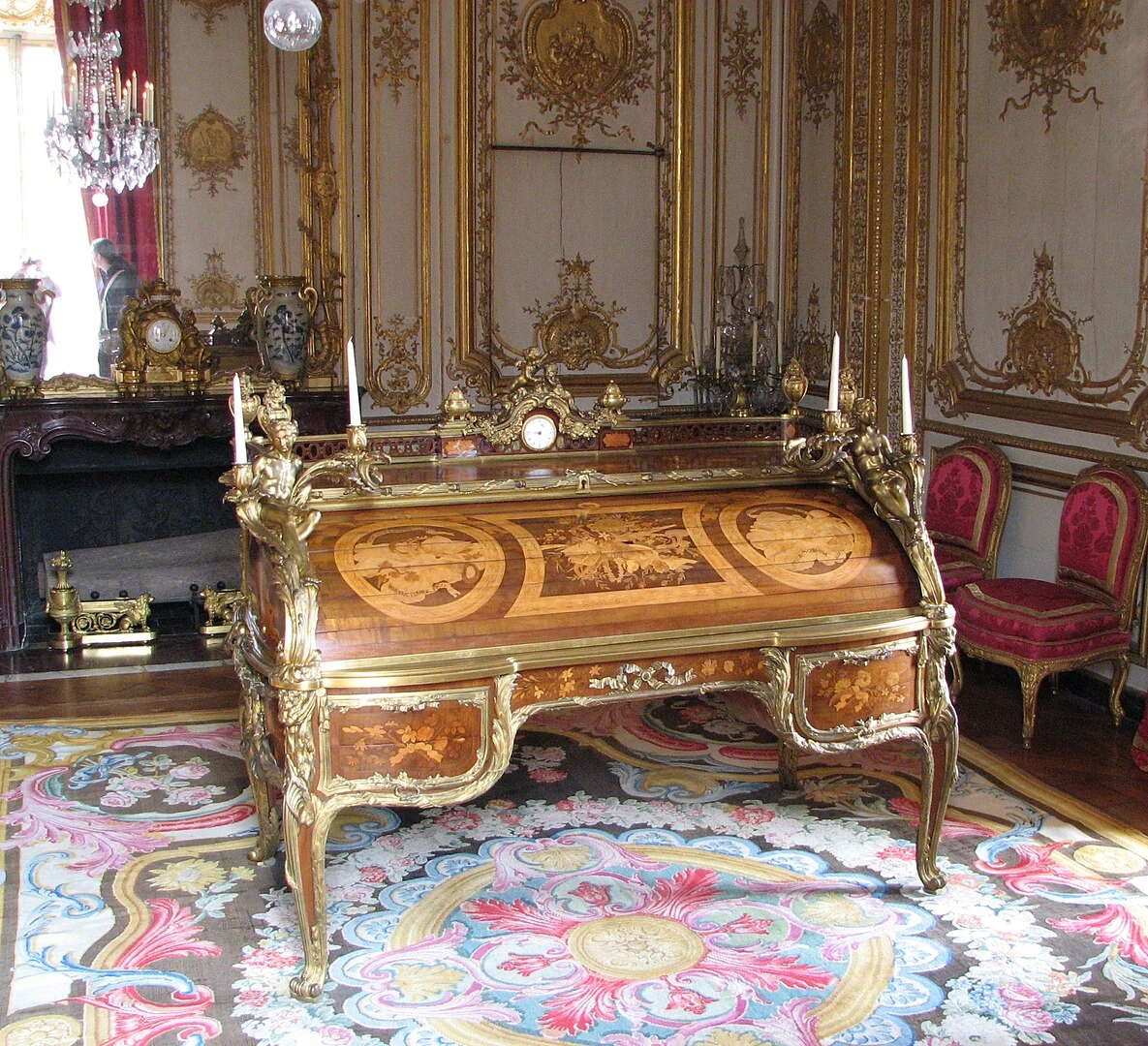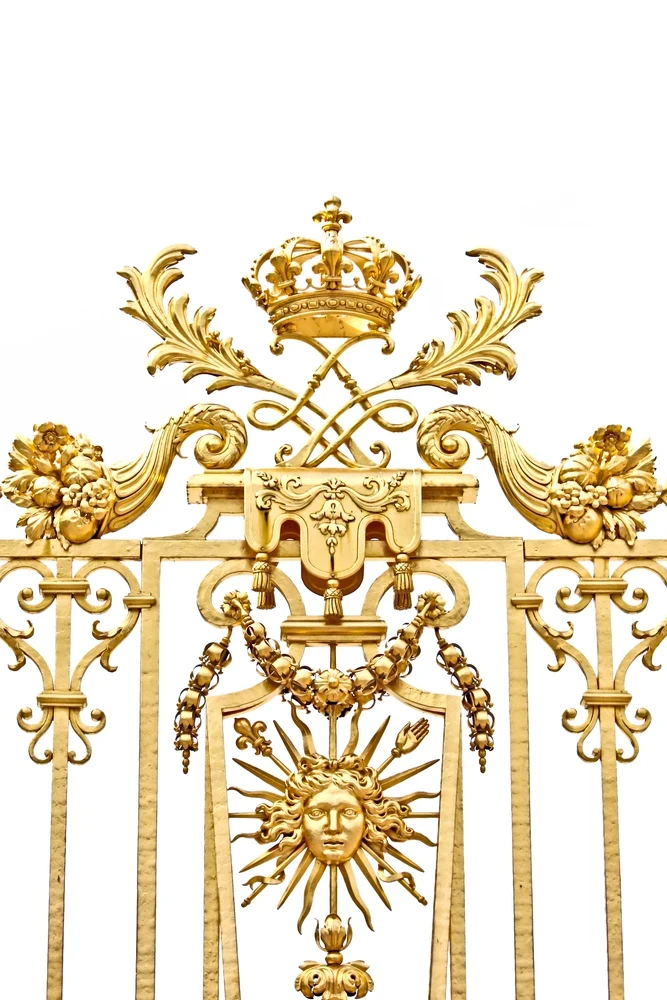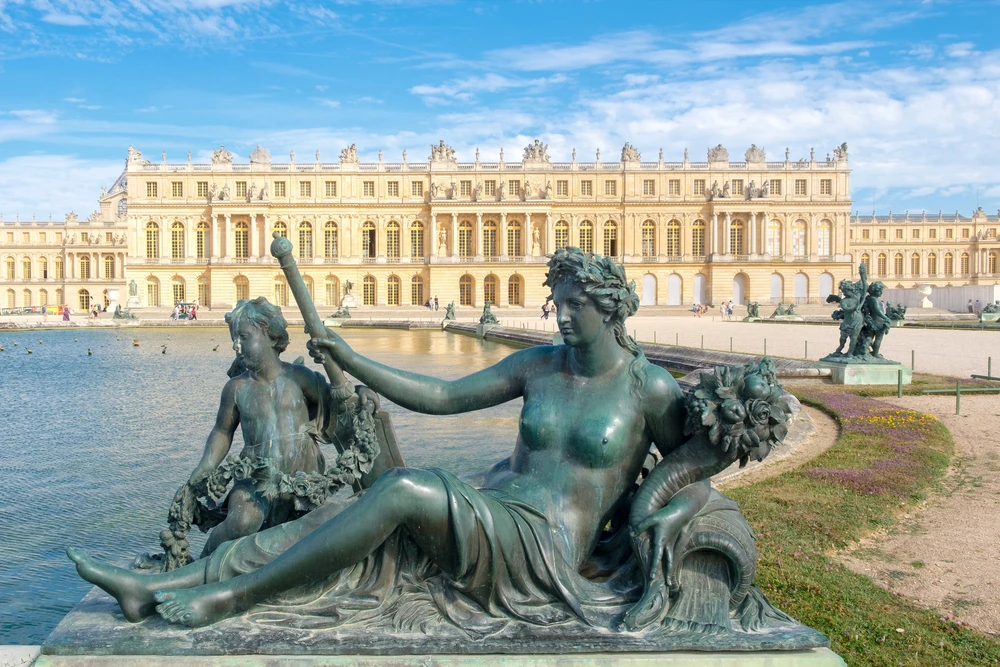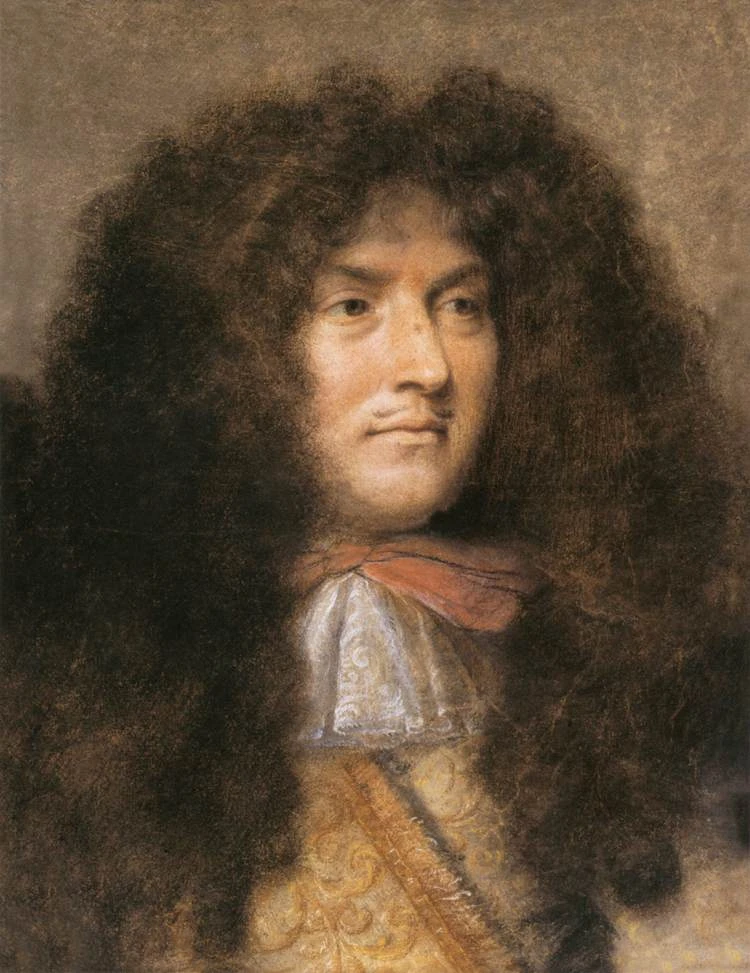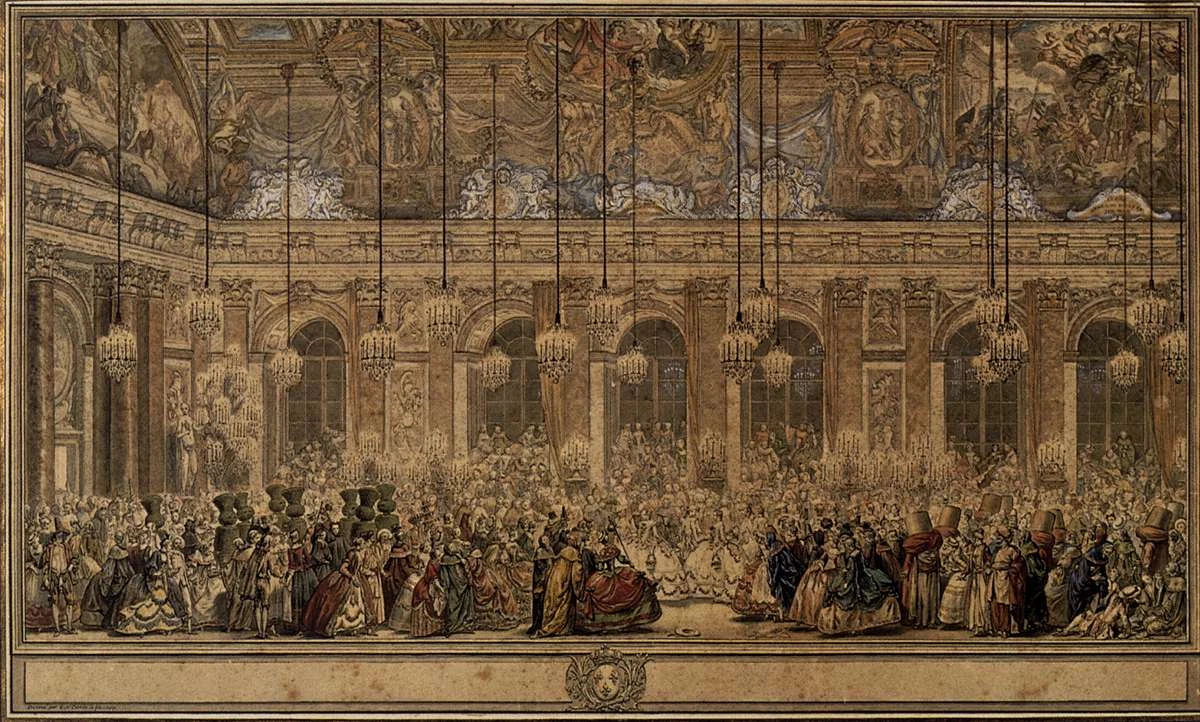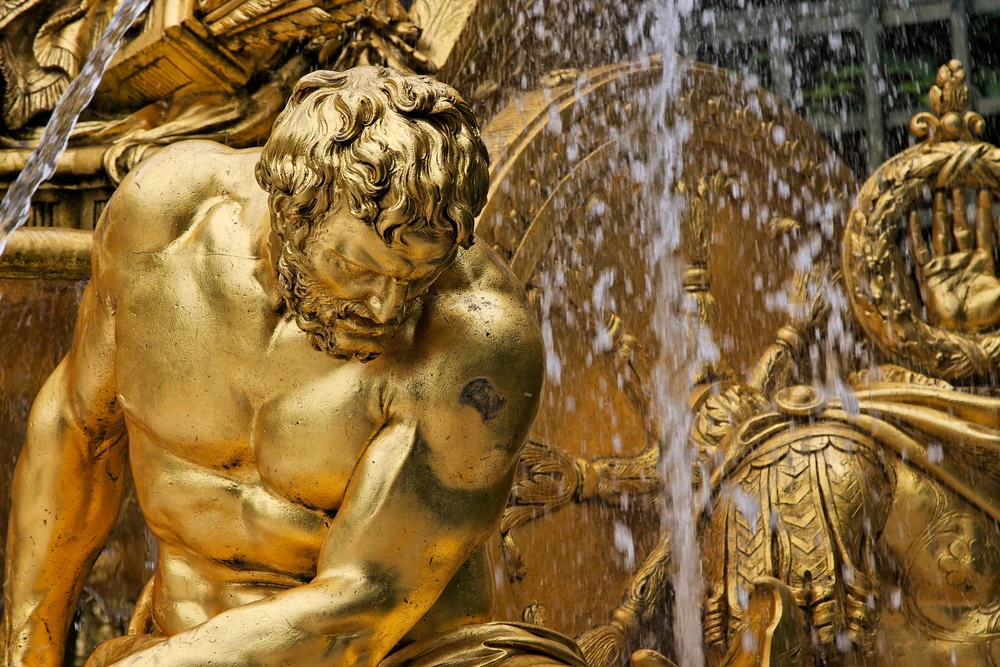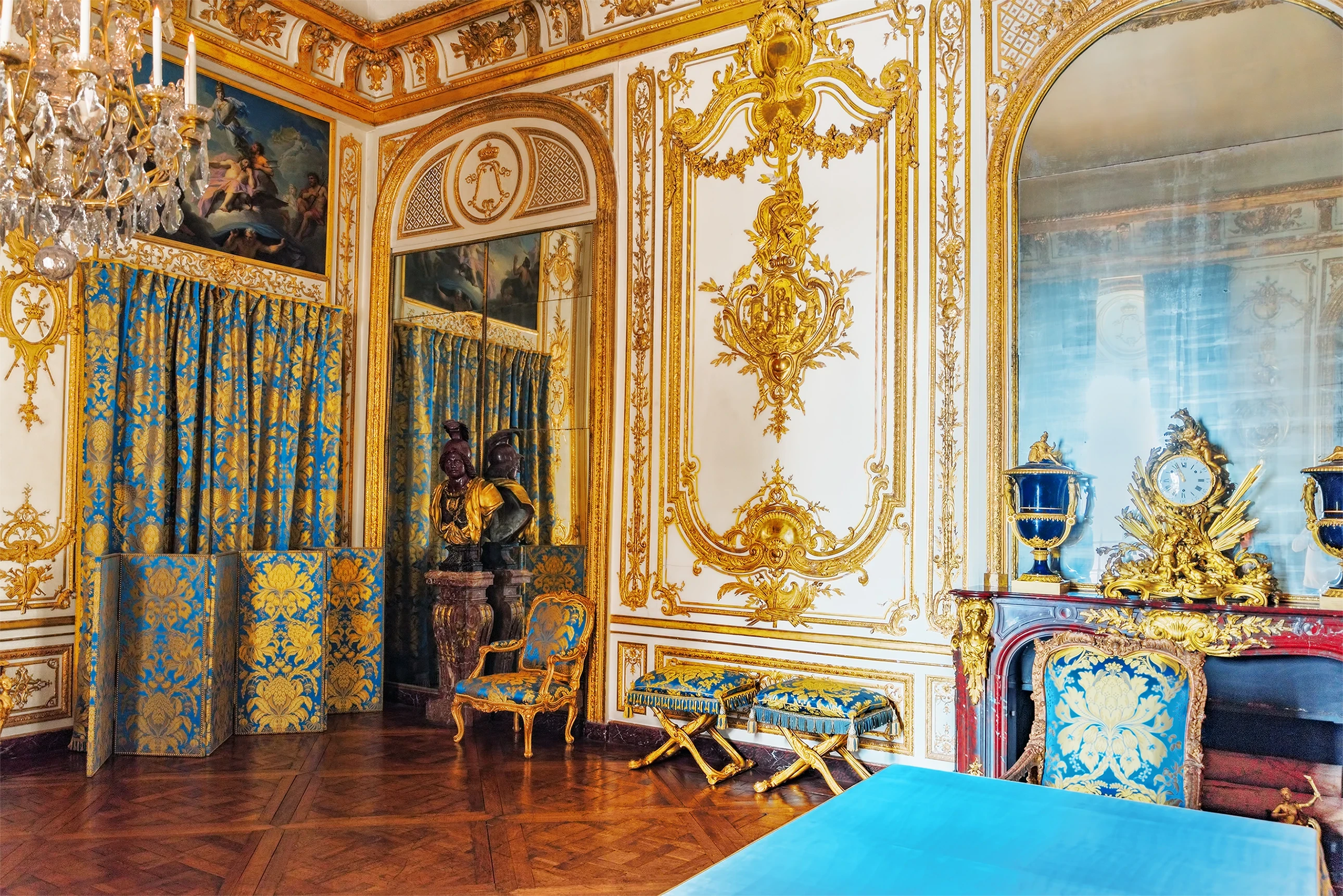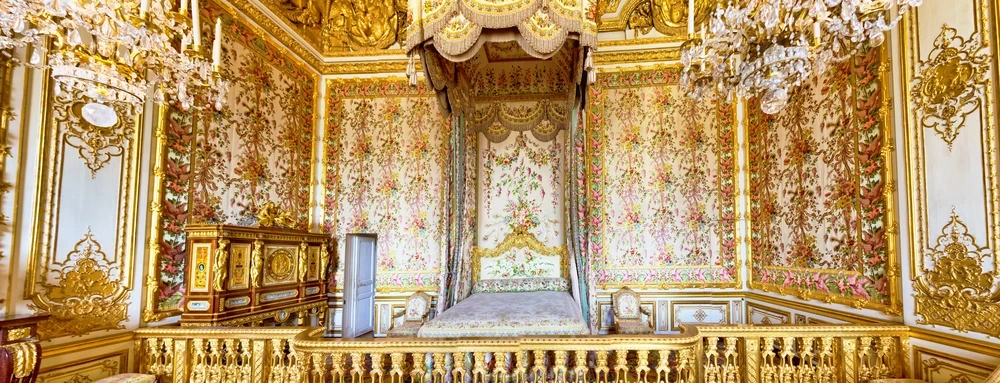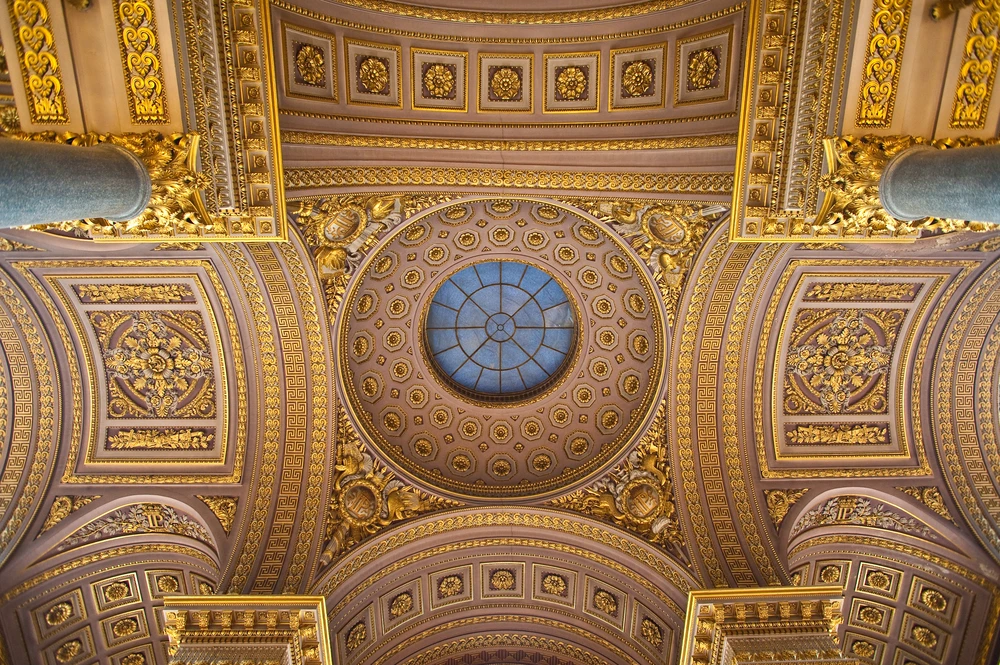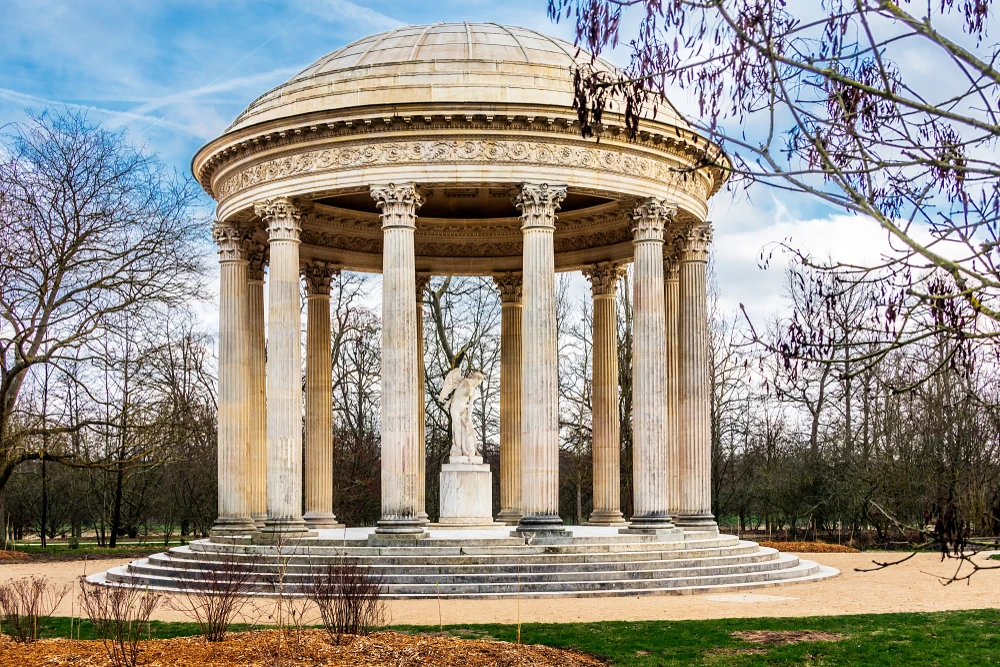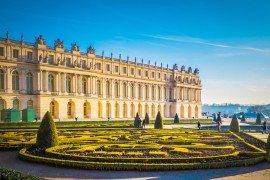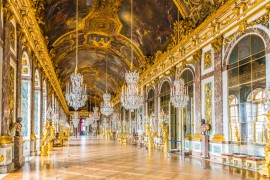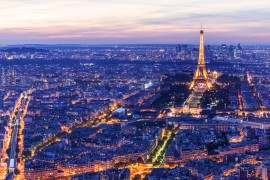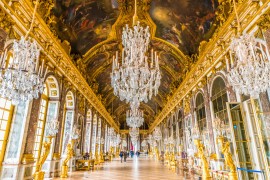West of Paris, the Château de Versailles emerges like an apparition of gold and stone. An absolute masterpiece of French classicism, it attracts over seven million visitors every year, fascinated by its balance and excess. Originally a simple hunting lodge built by Louis XIII, under Louis XIV it becomes a total universe: architecture, garden, water, light, music and protocol compose a vaiment royal symphony. Louis XV brings comfort. Marie Antoinette gave it more simplicity, and the Republic finally made it a majestic place to gather elected officials or impress official visitors.
The construction of the Château de Versailles By Adam François van der Meulen - 1. Adam Frans van der Meulen - Construction of the Château de Versailles2. Web Gallery of Art: Image Info about artwork, Public domain, https://commons.wikimedia.org/w/index.php?curid=15463386
The estate covers more than 800 hectares: château, French gardens, Grand Canal, Orangerie, Grand and Petit Trianon, Hameau de la Reine. Versailles is an ordered world, a city within a city, where everything obeyed the sovereign's rhythm. Even today, the place lives on: exhibitions, concerts, restorations and shows perpetuate the spirit of the Sun King.
Jardin et Château de Versailles/ photo Vivvi Smak/Shutterstock.com
Things to see and do in Versailles
Arrival at Versailles: the staging of power
The gold-leafed grille with the arms of France that closes the Cour d'Honneur at Versailles / photo chosen by Monsieur de France: by Rodrigo Pignatta de Pixabay
From the Place d'Armes, three avenues radiate towards the château like the rays of a sun. Every step prepares one for wonder: pavilions respond to each other, slate roofs frame the sky, and the great gilded portal announces magnificence. Crossing the cour d'Honneur, we do what few courtiers were allowed to do in the days of the kings, and enter a world where everything is symbol: geometry expresses order, gold reflects power, symmetry translates reason. Versailles begins with a lesson in grandeur.
The Marble Courtyard with the facades of the first château, that of Louis XIII / Photo by Fotos593/Shutterstock.com
The Grands Appartements: the theater of power
The War Room at the Château de Versailles image for Frederic Legrand - COMEO/Shutterstock.com
The Grands Appartements du Roi form a suite of mythological salons. Each room features a divinity - Hercules, Mars, Apollo, Diana - . The salon d'Apollon sums up this solar symbolism: the king, center of the world, shines on his kingdom. Ceilings painted by Charles Le Brun glorify the monarch's victories, while gilding and mirrors project the light of power. The King's Chamber is still that of Louis XIV (except that Louis XV had a fireplace added). This is where he died. It was customary to bow before the king's bed, even when he wasn't there;
Chambre du roi photo at Versailles. Photo chosen by Monsieur de France: by VICTOR TORRES/Shutterstock.com
Opposite, the Grand Appartement de la Reine celebrates feminine elegance and dignity. In the richly decorated Queen's chamber, naquirted nineteen princes and princesses of France. Today's décor is that intended by Marie-Antoinette. There are portraits of her family, and the eagle symbolizes her Habsburg-Lorraine family. It was from this room that the queen fled to join the king when the rioters of the October Days took the château. A door on the side of the bed is the one the queen used to leave. She was never to return to this room;
Queen's bedroom at Versailles. the Bed, the piece of furniture on the left is the jewel-stand which contained Queen Marie Antoinette's jewels. walter_g/Shutterstock.com
The Hall of Mirrors: France reflected
The Hall of Mirrors and its famous flares / Photo chosen by Monsieur de France: shutterstock.
73 meters long, lined with 357 mirrors, the Galerie des Glaces connects the royal apartments. Light, reflections, gilding: the décor speaks for the king. It was here that Louis XIV received foreign ambassadors, and where, in 1919, the Treaty of Versailles ending the First World War was signed.
To walk through the Hall of Mirrors is to enter a living image of the king's power, where time seems suspended between pomp and memory.
Detail of the Hall of Mirrors at the Château de Versailles Takashi Images/Shutterstock.com
The Chapelle Royale: faith in the service of power
Completed in 1710, the Chapelle Royale combines majesty and spirituality. It was the very last building project of the Sun King. Louis XIV attended mass from the upper gallery, overlooking the nave and its faithful. Architecture becomes stone prayer. Corinthian columns, colorful marble and Jouvenet's painted vault are a reminder that, for Louis XIV, the kingdom and faith were one and the same. Even today, the chapel resonates with sacred music concerts that recall the fervor of the Grand Siècle.
Versailles: the chapel interior seen from the upper salon / Image by lexan/Shutterstock.com
The gardens of Versailles: the art of taming nature
Le bassin de Latone / Image par 365 Focus Photography/Shutterstock.com
The work of André Le Nôtre, the French gardens extend the palace like a mirror of order and beauty. Descending to the Parterre d'Eau, statues and basins line up in perfect geometric logic. The Bassin de Latone evokes the divine justice of royal power: the goddess punishes those who dare to defy authority.
The parterres of the French garden, a springtime delight / Image by Smokedsalmon/Shutterstock
Further on, the Bassin d'Apollon shows the chariot of the sun god, a direct allegory of the Sun King himself. At Versailles, mythology becomes political language.
The Fountain of Appolon / Image by Mistervlad/Shutterstock.com
The bosquets hide a thousand surprises: Salle de Bal, Colonnade, Théâtre d'Eau... So many green salons where parties and ballets were held. The 1.5-kilometer-long Grand Canal extends the perspective, inviting visitors to stroll along. In his day, Louis XIV sailed gondolas from Venice.
The Orangerie, an immense stone nave, is home to hundreds of orange, lemon and laurel trees that perfume the estate in summer. It's a Versailles of the South, bathed in light.
The Grand Canal / Domaine de Versailles / Image by Vladimir Osipov/Shutterstock
The Grand and Petit Trianon: intimate Versailles
The Grand Trianon: elegance in pink marble
The facades of the Grand Trianon / Image by Mistervlad/shutterstock
Imagined by Jules Hardouin-Mansart in 1687, the Grand Trianon was commissioned by Louis XIV as a place to rest, away from the stifling protocol of the château. Built of rose marble from the Pyrenees, this palace is distinguished by its galleries opening onto the gardens and its architecture that is both refined and sober.
Here, the king could breathe, receive a few loved ones, converse, or simply admire the changing light on the flowerbeds. The decor here is of a more intimate taste: delicate furnishings, fine woodwork, and a calming perspective. Under Napoleon I, the place regained its glory: he often stayed there with Empress Marie-Louise, and the apartments were redecorated in his image. Today, the Grand Trianon welcomes official guests of the French Republic on state visits, perpetuating its vocation for hospitality and elegance.
Columns of the Grand Trianon / Photo by Andre Quinou/Shutterstock.com
The Petit Trianon: Marie-Antoinette's freedom
Le petit Trianon / Image Pack-Shot/Schutterstock.com
Just a stone's throw from the Grand Trianon, the Petit Trianon offers a completely different face. Built by Jacques-Ange Gabriel for Louis XV, it was presented to Marie-Antoinette upon her arrival at court. The young queen made it her refuge, a place of simplicity and freedom far from the heavy gaze of Versailles. Its architecture is a masterpiece of sobriety and balance: four different yet harmonious facades, a refined interior décor, salons bathed in light.
The Temple of Love / Photo by Fabianodp/Shutterstock.com
Around the pavilion, the queen created her own universe: the English Garden, then the famous Queen's Hamlet, a small country village made up of thatched cottages, a mill, a dairy and vegetable gardens. This place, often caricatured, was not a caprice but a laboratory of agricultural and aesthetic experiments. Marie-Antoinette cultivated the art of staged nature here. Today, the Petit Trianon can be visited freely, and there is a moving atmosphere: that of a woman in search of air and truth in a world frozen by etiquette.
The Marlborough Tower and the Queen's Hamlet / Versailles / Image by Takashi Images
Versailles: the enhanced experience
Château de Versailles / By night / younes_bkl/Shutterstock
The Great Waters of Versailles
At Versailles, water speaks and music answers. Every year, from April to October, the Grandes Eaux Musicales bring the fountains and basins designed by André Le Nôtre back to life. Water rises, dances and falls to the rhythm of compositions by Lully, Rameau or Charpentier. It's a dialogue between nature, art and light, a suspended moment when Versailles rediscovers the voice of the Sun King. The Grandes Eaux Musicales take place on Saturdays, Sundays and some Tuesdays, while the Grandes Eaux Nocturnes, held on Saturday evenings, offer a fairytale spectacle of water displays, lights and fireworks. The whole garden lights up, the basins come alive and music fills the walkways: it's Versailles alive, just like in the XVIIᵉ century.
To experience the Grandes Eaux is to relive the sumptuous evenings of the Sun King, when the garden became a theater and France, a spectacle. Times vary according to the season: during the day from 10 am to 7 pm, and for nocturnes from 8:30 pm to 11:05 pm. Prices range from €10 to €12 for the Grandes Eaux Musicales and up to €30 for the Grandes Eaux Nocturnes.
⚠️ Tickets can only be purchased on the official website of the Domaine national de Versailles (www.chateauversailles.fr). Beware of the first sponsored results on search engines, often private resellers charging inflated rates or invalid offers.
The Little Apartments and the Royal Opera House
There are many ways to discover the Domaine de Versailles. On reservation, you can visit Madame du Barry's apartments (on the 2nd floor), the King's small apartments (including the magnificent bueau) and the Versailles Opera, pictured here by Isogood_patrick/shutterstock.com.
Behind the castle's grandiose façade lie more secret places: the Petits Appartements du Roi et de la Reine, reserved for the private life of the sovereigns. Here, no more ceremony: the pomp gives way to gentleness and confidence.
We discover the private salons of Louis XV and Louis XVI, their libraries, their study cabinets, the boudoirs of Marie-Antoinette, a whole world of refinement and silences. These spaces are accessible only on guided tours, offered by château lecturers, in groups limited to a maximum of twenty people.
Tours last approximately 1 h 30 and are booked exclusively on the official Domaine national de Versailles website (www.chateauversailles.fr). The average price is €12 in addition to the entrance ticket, free for under-26s from the European Union. It's advisable to book several days in advance, especially at weekends. These apartments are the Versailles of whispers, perfumes and everyday gestures: a place where power takes off its mask.
The office of King Louis XV is the most beautiful office in the world and is full of secret parts / By TCY - Own work, CC BY-SA 3.0, https://commons.wikimedia.org/w/index.php?curid=14185999
Another exceptional venue, the Opéra Royal, inaugurated in 1770 for the wedding of the future Louis XVI and Marie-Antoinette, is one of the most beautiful theaters in Europe. All in painted wood imitating marble, it offers perfect acoustics and an atmosphere of gold and velvet.
The Opéra can be visited on special tours, but also experienced at concerts, operas and ballets played on period instruments. Rates vary according to programming, from €25 to over €100 for major events.
Attending a concert at the Opéra Royal is to experience Versailles as a spectator of the XVIIIᵉ century, between lights, music and history rediscovered.
Anecdotes and secrets from Versailles
The sun, the symbol of Louis XIV, is featured on a number of items, including honorary railings / Photo by trucic/Shutterstock.com
At Versailles, each stone has a story, each room an anecdote.
In the king's bedroom, for example, the four-poster bed symbolizes the state itself. Louis XIV appeared here every morning during the Lever du Roi, a public ceremony attended by courtiers. To be admitted to the rising was to be seen by the Sun.
Under Louis XV, the château became a place of science: the astronomy-loving king installed an observatory and brought in instruments from England.
It is also said that Marie-Antoinette used to stroll incognito in the gardens of the Petit Trianon, dressed as a shepherdess. People saw it as a whim; she saw it as a refuge.
And did you know that the bassin d'Apollon was once a simple carp pond? After years of work, it became a symbol of solar power. This is Versailles: a living theater where every detail carries a message.
The history of the Château de Versailles
Palace of Versailles, view from the gardens / depositphotos
From hunting to royal glory
It all began in 1623, when Louis XIII had a simple hunting lodge built on marshy land. The location appealed for its tranquility. His son, Louis XIV, saw it as a refuge from Paris, which he deemed too restless. In 1661, he ordered Le Vau, Le Brun and Le Nôtre to enlarge the residence. Versailles then became the mirror of absolute power. The king wanted a palace worthy of France: art at the service of the state. The worksite lasts for decades and mobilizes thousands of workers. Everything is designed to glorify the monarch.
Louis XIV par Charles Le Brun / Par ChaWeb Gallery of Art: Image Info about artwork, Domaine public, https://commons.wikimedia.org/w/index.php?curid=15497120
Versailles, capital of the kingdom
From 1682, Louis XIV set up the Court and government at Versailles. The palace becomes the beating heart of the kingdom. Every day, rituals punctuated life: the Rising, the Council, Mass, the King's Supper. The castle becomes a machine for ruling as much as for glittering. Artists, scholars, diplomats parade through. Versailles is France's showcase. Under Louis XV, decor becomes more refined, apartments multiply, and the king's private life takes hold. Rococaille art and delicacy replace the pomp of the Grand Siècle.
Masked ball given by Louis XV in the "Grande Galerie" Source: wikicommons
Marie-Antoinette and the broken dream
When Louis XVI acceded to the throne, Versailles remained the symbol of the monarchy, but also of its distance from the people. Marie-Antoinette transforms the Petit Trianon into an intimate refuge, far from protocol. The Revolution of 1789 put an end to this world. On October 5, the people of Paris march on Versailles and force the royal family to leave the château, never to return. During the Revolution, the furniture is sold, the gilding tarnished. Versailles becomes a museum of emptiness.
Marie Antoinette and her children, by Elisabeth Vigée-Lebrun. They include the future "Madame Royale" Marie Thérèse (the Queen's eldest daughter), the first Dauphin (who died of tuberculosis in 1789), and the young Duke of Normandy (who became Dauphin and died in Temple Prison at the age of 12).
The empty cradle refers to the absence of "Madame Sophie", the last child of Marie Antoinette and Louis XVI, who died as a child, very recently, at the time the painting was created by the Queen's official painter;
Versailles is reborn
In the XIXᵉ century, Louis-Philippe transformed the château into a musée de l'Histoire de France. Historical paintings and busts of heroes replace courtiers. In 1919, the Galerie des Glaces regains its role as a world stage: the Traité de Versailles is signed there, marking the end of the Great War.
Today, Versailles is reborn once again. Thanks to restoration and exhibitions, the château lives in the present. Visitors from all over the world come here in search of an image of eternal France.
Practical information
Water has always been in short supply at Versailles, and it's a real privilege for our times to see the fountains running full tilt / Photo chosen by monsieurdefrance.com: depositphotos
Address: Place d'Armes, 78000 Versailles, France
How to find us :
- By RER C train from Paris: "Versailles Château - Rive Gauche" stop (10-minute walk from the château)
- By train from Montparnasse: "Versailles Chantiers" station
- By car: A13 freeway, Versailles Centre exit (paying parking lots around the château)
Opening hours :
- Château: daily except Monday, from 9 a.m. to 6:30 p.m. (last entry at 6 p.m.)
- Jardins: open daily from 8 a.m.
- Trianons: from 12 p.m. to 6:30 p.m.
ATTENTION: The Versailles estate is ALWAYS closed on Mondays;
Le cabinet du Conseil : detail / Photo by V_E/Shutterstock.com
Toilets, lockers and accessibility
The Versailles estate is huge, but everything is planned for the comfort of visitors.
Free toilets are available at several locations: in the Cour des Ministres (before the château entrance), near the Café d'Orléans, at the Grand Trianon, at the Petit Trianon, and around the Grand Canal.
Free consignes allow you to drop off bulky bags, umbrellas or strollers at the entrance to the Château and Grand Trianon. To preserve the collections, oversized objects are not allowed inside.
The site is partially accessible to people with reduced mobility: ramps, elevators and wheelchairs are available on request. visitors with disabilities benefit from free admission for themselves and their companion.
To facilitate the visit, the Domaine national de Versailles also provides adapted access maps and audioguides compatible with hearing aid devices.
Queen's bedroom at Versailles. the Bed. The ballustrade separated the Queen and authorized ladies from the rest of the court. This is where Marie Antoinette gave birth in public. It was so crowded, Louis XVI had to push the courtiers to break a tile and open the window. V_E.Shutterstock.com
Official websites to help you prepare for your visit
For up-to-date information on opening times, prices and exhibitions, always consult the official websites:
- Domaine national de Versailles : www.chateauversailles.fr
- Office de tourisme de Versailles : www.versailles-tourisme.com
⚠️ Tickets may only be purchased via these links. Beware of the first search results, often unofficial resellers with inflated prices.
Inside the Château de Versailles / Photo by Matthew Jacques/Shutterstock.com
FAQ: everything you need to know about the Château de Versailles
How many people visit Versailles each year?
Some 7 to 8 million visitors come to discover the château and its gardens every year.
When is the best time to visit Versailles?
Spring and early autumn are ideal: less crowds, soft light, flowering gardens.
Do I need to book tickets in advance?
Yes, especially in high season. Online booking on the official website is highly recommended.
Can we visit the whole estate in a day?
It's possible, but difficult. Better to plan two days: one for the château and gardens, one for the Trianons and Hamlet.
The temple of love in the gardens of the Petit Trianon/ Image Jacky D/Schutterstock.com
Are there any nocturnal visits?
Yes, the Grandes Eaux Nocturnes every Saturday in summer offer a magical spectacle of fountains and fireworks.
Are gardens free?
Yes, except on Grandes Eaux Musicales and Jardins Musicaux days, when a specific ticket is required.
Can you picnic at Versailles?
Not on the main estate, but there are dedicated areas near the Grand Canal.
Is Versailles accessible to people with reduced mobility?
Yes, most of the main areas are adapted, with free wheelchair loans and elevators in the wings.
Where to eat nearby?
Several restaurants are located around the château and in the park, notably in the Petites Écuries and near the Grand Canal.
Official and reference sources
- www.chateauversailles.fr
- www.versailles-tourisme.com
- en.wikipedia.org/wiki/Château_de_Versailles
- data.culture.gouv.fr

